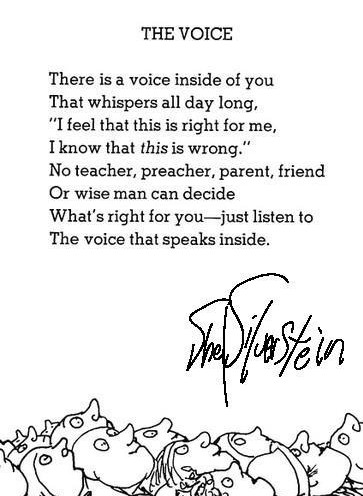The Voice That Speaks Inside

The Voice, by Shel Silverstein
Ahh, yes! The voice that speaks inside. And yet, how often do we deny or crush that voice? How often do we argue with that voice or make it wrong?
What if you’re not wrong? What if you stopped drowning out that voice and started listening to its every little whisper? What would it have to tell you? What would it show you about your life, about your heart, about your preferences, choices, desires and ultimately your happiness and wellbeing?
How many times a day to you deny that voice, make yourself wrong?
Where in your life is that habit most strong?
As children, this voice is most often loud and clear. Most children do not argue with themselves. In my experience with the probably at this point thousands of children I’ve worked with, lived with and shared with, children have a degree of knowing and clarity about themselves and their truth that is often trained out of them to the point that it becomes extremely difficult to access in adulthood.
True, there’s lots of things and perspectives and awareness that adults have and are considering that children don’t. Somewhere along the line however, and probably more as a gradual process and not as a sudden one, we were taught and trained out of listening to our own inner whisper that knows with clarity what is true for us without the fog or confusion of other people’s opinions.
How would it be, what would your life be like if you could reclaim a little bit of that knowing, a little bit of a greater trust in your own being? What would you choose, how would you be if you listened to that whispering voice inside rather than the cacophony of external messages, voices and opinions.
What would it take to cultivate trusting to and listening to that little inner whisper again?
Here’s some hints and tools to get you started:
Pay attention to your feelings: Feelings are indicators of needs, feelings are there to give you information about your needs- if you can indentify your needs it will help deepen your self-understanding and clarity and to know what is true for you. If you want to explore this more, read my post Trusting the Intelligence of Your Design.
Know what’s yours and what’s not: as kids, one of the reasons we can hear our own inner whisper better than we can as adutls is that it’s not crowded out by the messages and voices of so many others. Part of the task of hearing that whisper is to stop hearing (and believing!) everything everyone else is saying. You can ask yourself “who’s voice is that” and if it’s not yours, then you can tell it “thanks for sharing” and get back to paying attention to what is truly true for you. More tools for knowing what’s yours and what’s not HERE
Make a habit and practice of listening: If you’re wondering about something or have a choice to make, get quiet, move past the constant chatter of your mind to see if you can find a deeper truth for you. In Access Consciousness they say, “The truth will always make you feel lighter and a lie will make you feel heavier” so feel into what has a sense of lightness, ease, or peace for you. That is your inner whisper letting you know what’s true for you. Do it with the little things that don’t have big consequences, like maybe, what to eat for breakfast, if you train yourself to listen to the little things, then when you’re faced with something bigger, you will have taught yourself how to listen and have much more awareness to draw from.

[…] Skip to content ← The voice that speaks inside […]